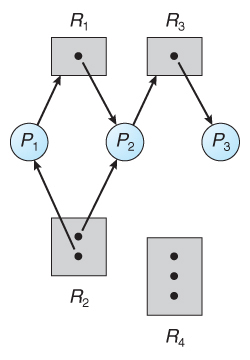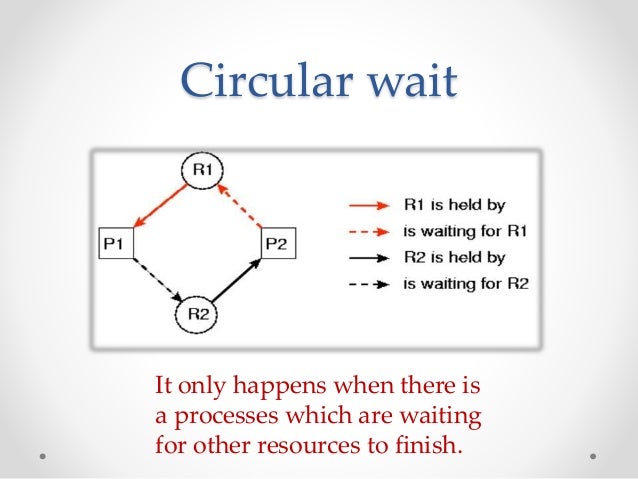🔒 DEADLOCK: Complete Visual Guide
Master Deadlock Concepts for Interviews & Exams
🎯 What is Deadlock?

Both cars are stuck forever!
Computer Science Definition:
Deadlock: A situation where two or more processes are permanently blocked, each waiting for resources held by the other processes.
🏗️ Resource Utilization Process
Ask for resource
Work with resource
Free the resource
Process-Resource Interaction

Process → Resource (Request), Resource → Process (Allocation)
⚠️ Four Necessary Conditions for Deadlock
ALL FOUR must be present simultaneously for deadlock to occur!
1. Mutual Exclusion
Only ONE process can use a resource at a time
2. Hold & Wait
Process holds resources while waiting for more
3. No Preemption
Resources cannot be forcibly taken away
4. Circular Wait
Processes form a circular chain of waiting
Circular Wait Example

🛠️ Methods to Handle Deadlock
1. 🚫 Prevention
Strategy: Prevent at least one of the four conditions
- ✅ Guaranteed no deadlock
- ❌ May reduce system efficiency
- ❌ May waste resources
2. 🎯 Avoidance
Strategy: Use algorithms to avoid unsafe states
- ✅ More efficient than prevention
- ✅ Uses Banker's Algorithm
- ❌ Requires advance resource info
3. 🔍 Detection & Recovery
Strategy: Allow deadlock, then detect and recover
- ✅ Maximum resource utilization
- ❌ Overhead of detection
- ❌ Recovery can be expensive
4. 🙈 Ignore (Ostrich Algorithm)
Strategy: Pretend deadlocks don't happen
- ✅ No overhead
- ✅ Used by many real systems
- ❌ System may hang
🔒 Deadlock Prevention Techniques
| Condition | Prevention Method | Pros | Cons | Example |
|---|---|---|---|---|
| Mutual Exclusion | Make resources shareable whenever possible | Simple to apply for some resources (e.g., read-only files) | Not possible for resources that must be used exclusively (e.g., printer) | Allow multiple processes to read the same file in parallel |
| Hold & Wait | Require processes to request all resources at once before execution | Eliminates partial allocation → prevents circular dependency | May cause resource underutilization and starvation if a process holds resources it doesn’t need yet | A program must request CPU, memory, and disk all at once before starting |
| No Preemption | If a process holding some resources requests others and can’t get them, release its current resources | Breaks potential deadlock cycle by freeing resources | Frequent preemptions can cause livelock (processes repeatedly release and reacquire resources without progress) | If a process holding CPU and requesting I/O can’t get it, CPU is preempted and given to another |
| Circular Wait | Impose a linear ordering on resource types and require processes to request in increasing order | Most practical and widely used method | Requires predefined ordering of all resources, which may not always be flexible | A process must request printer (R1) before scanner (R2); cannot request in reverse |
🏦 Banker's Algorithm (Deadlock Avoidance)
Safe State Example

How Banker's Algorithm Works:
- Check Available Resources: Can we satisfy at least one process?
- Find Safe Sequence: Order processes so all can complete
- Grant or Deny: Allow request only if system stays safe
🔍 Deadlock Detection
Wait-for Graph Method

Detection Frequency:
- Every resource request: High overhead, immediate detection
- Periodic intervals: Balanced approach
- When CPU utilization drops: Indicates possible deadlock
🔄 Recovery from Deadlock

Process Termination
- Abort All: Terminate all deadlocked processes
- Abort One by One: Terminate processes until deadlock breaks
Selection Criteria: Priority, computation time, resources held
Resource Preemption
- Select Victim: Choose process to preempt from
- Rollback: Return process to safe state
- Starvation: Ensure same process isn't always selected
📊 Comparison of Deadlock Handling Methods
| Method | Resource Utilization | System Throughput | Implementation | Real-world Usage |
|---|---|---|---|---|
| Prevention | Low | Low | Simple | Limited |
| Avoidance | Medium | Medium | Complex | Specialized systems |
| Detection | High | Medium | Medium | Database systems |
| Ignorance | High | High | None | Most OS (Windows, Linux) |
🎯 Quick Interview Facts
- Deadlock vs Starvation: Deadlock affects multiple processes; starvation affects one process indefinitely
- Livelock: Processes keep changing state but make no progress
- Resource Allocation Graph: Visual representation of process-resource relationships
- Safe vs Unsafe: Safe state guarantees no deadlock; unsafe state may lead to deadlock
- Dining Philosophers: Classic deadlock problem demonstrating circular wait
- Real Systems: Most modern OS use "ignore" approach for simplicity
🎪 Common Interview Questions
Q: What happens if we remove one of the four conditions?
A: Deadlock cannot occur. This is the basis of deadlock prevention - eliminate at least one necessary condition.
Q: Why don't most operating systems prevent deadlocks?
A: Prevention methods reduce system efficiency and resource utilization. Deadlocks are rare in practice, so most systems use the "ignore" approach.
Q: Explain the difference between deadlock and starvation.
A: Deadlock is mutual waiting (circular), while starvation is indefinite waiting due to resource allocation policies.
Q: How does Banker's Algorithm ensure safety?
A: It simulates resource allocation and checks if a safe sequence exists. If not, it denies the request.